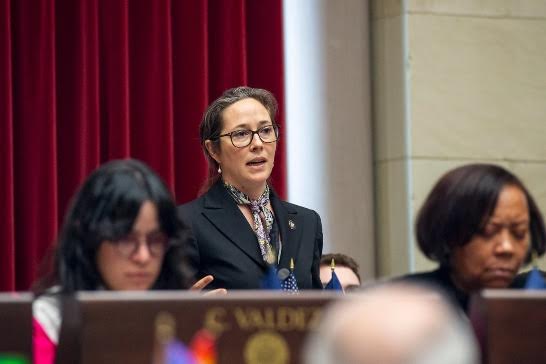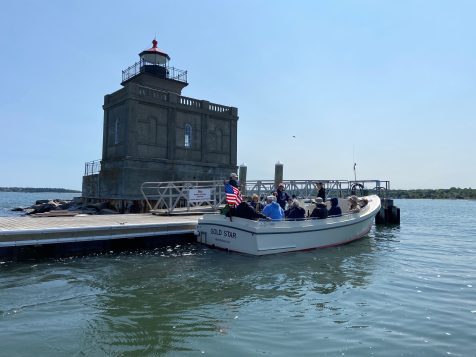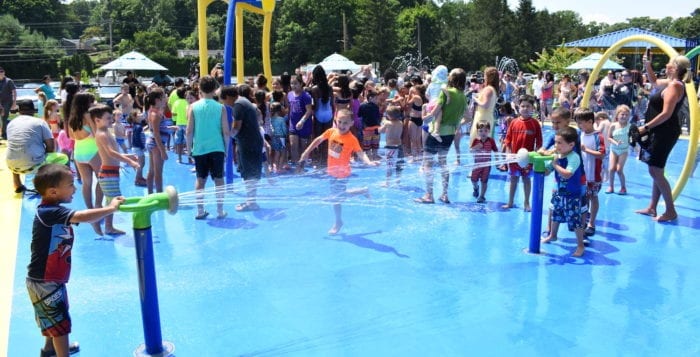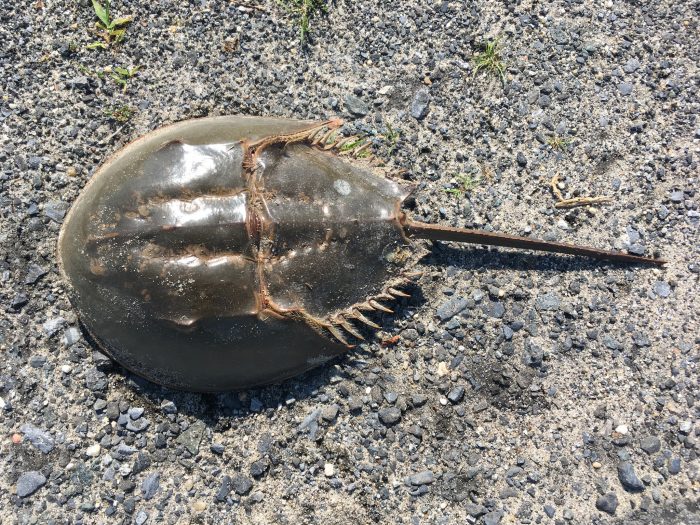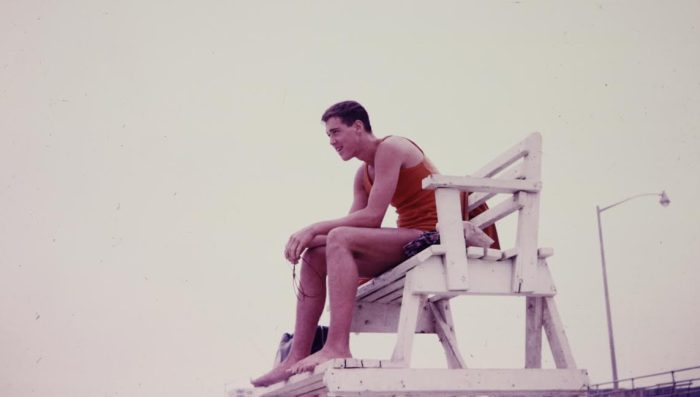Huntington Lighthouse Preservation Society announces 2025 summer schedule
First tour of the season is June 22
The Huntington Lighthouse Preservation Society (HLPS) is celebrating its 40th anniversary this year with new tours and ways for the public to enjoy the 113-year old historic lighthouse. Founded in 1985 as Save Huntington’s Lighthouse, the non-profit, volunteer effort is gearing up for a busy summer season.
“Each year we see more and more boats on the water, which means that the Huntington Lighthouse’s primary job as a working navigational aid is more important than ever,” said Pam Setchell, HLPS President. “Maintaining the lighthouse takes a massive volunteer effort. Looking back over the past 40 years, we are incredibly proud of all we have accomplished to help Huntington’s lighthouse, including saving it from scheduled demolition. The team has been hard at work preparing for the season, and our first scheduled tour on June 22.”
A Renewed Focus on Renovation + New Windows!
The ongoing restoration of a historical structure is never easy, and the unique location of the Huntington Light amplifies the challenges. Since the inception of the Save Huntington’s Lighthouse group in 1985, and then the Huntington Lighthouse Preservation Society, the preservation and restoration of the lighthouse has remained a top priority.

Through a combination of public and private grants, private donations, seasonal tours, special events, and merchandise sales, HLPS has raised approximately $3.5 million in its 40-year history for improvements and restoration projects.
Already this spring, new, custom-fabricated windows have replaced the original windows, made possible by a generous grant from the Gardiner Foundation and a matching private donation. The windows were brought out to the lighthouse via boat, and carefully hoisted into place.
“The windows were meticulously designed to reflect the style of the original lighthouse windows and mark an important step in our continued efforts to maintain the Huntington Light for future generations,” said Setchell.
Additional projects include roof repairs and protective matting, wrought iron railings, repairing cracks in the building’s exterior masonry, and painting and repairing the cupola. A new custom watch deck door is also going to be installed. Each project requires careful planning to ensure that the building’s history and design are maintained. Everything that’s needed, including supplies, tools, and crew must be transported by water and can only be accomplished during a limited season.
New Website Launched
Supporting the improved online reservation system is a newly launched Huntington Lighthouse Preservation Society website. The new website is easier to navigate, offers bookings for tours, and additional merchandise sales.
New Partners
HLPS is proud to partner with Discover Long Island, the region’s premiere destination marketing organization. Check out our new commercial, airing this spring and summer, and filmed at the Lighthouse!
Resident Ospreys
The Huntington Lighthouse welcomes the return of its resident ospreys to an upgraded, reinforced nesting platform. The pair first settled in their summer waterfront property in 2021, and in 2023 welcomed their first viable hatchlings. This year, two eggs have been spotted in the nest – stay tuned for updates
Lighthouse Tours
Offering access and sharing the story of the lighthouse are core to the HLPS’s mission. Due to an increase in demand, more tours have been added this summer season, including dinner tours. The first tour date is scheduled for Sunday, June 22, and additional dates can be found here.
New this year – guests can reserve tour dates and prepay online. Tours last about 90 minutes and include a boat ride to and from Gold Star Battalion Beach, Browns Road, Huntington to the offshore lighthouse.
All tour dates are weather and wind permitting, please check the HLPS Facebook, and Instagram pages for the most updated information.
2025 Tour Dates *
June 22
July 13
July 27
August 10
August 24
September 14
September 28
HLPS continues to make the lighthouse available for group tours by school groups and others wanting to learn more about maritime history and visit a working lighthouse.
*Please note that tours are available for ages 5 and above, and the lighthouse is not handicapped accessible.
Sunken Meadow Park to host Sand Castle Contest for the summer
New York State Office of Parks, Recreation and Historic Preservation will host a Sand Castle Contest at Sunken Meadow State Park, Field #1, 1 Sunken Meadow Parkway, Kings Park on Tuesdays, June 24, July 15, and August 19.
Each week, prizes will be awarded for the best sculptors and castles in several categories. T-shirts will be provided by the Natural Heritage Trust.
Sand sculptors may use sand, water, and any other natural materials native to the beach. Registration is held at 9:30 a.m. at the Main Beach Boardwalk, build time is from 9:30 a.m. to 10:30 a.m., judging is at 10:30 a.m. and an awards ceremony will be held at 11 a.m. A $10 vehicle use fee will be in effect. For further information, call 631-269-4333, ext. 0.
Town of Huntington prepares for heat wave with free admission to pools and spray parks
As a community service and in-light of the expected heat wave, the Town of Huntington will be allowing Huntington residents to use the Manor Field Park and Elwood Spray Parks free of charge during the duration of heat wave (6/22 – 6/26). Proof of residency is required. Elwood and Manor Field Spray Parks will be open from 11 a.m. to 6 p.m during this period.
“For some of our residents, staying cool during these frequent summer heat waves can be a challenge,” said Huntington Supervisor Ed Smyth. “Offering the spray parks to our residents with children is the best kind of community service – convenient, safe, fun and for now, free.”
Spray Parks will return to regular hours with a required Town Recreation Card on Thursday, June 26. (If weather permits, may be extended).
In anticipation of the forecasted heat wave, the Town of Huntington will also put the following services and schedules in place:
Cooling center: The Town of Huntington Flanagan Senior Center will be open Monday through Friday until 5 p.m.
Beaches – Town Residents ONLY: Gold Star Battalion, Crab Meadow, West Neck, Hobart, and Centerport Beaches will be open with stationed lifeguards until 8 p.m. Beach Permits required. Residents can visit www.tohbeachpermit.com to obtain a virtual beach permit.
Dix Hills Pool: The Dix Hills Pool will also be free to residents during the heat wave –
(Saturday, June 21 – Wednesday, June 25) – The following community hours will apply:
- Saturday (6/21): 11:00 AM – 8:00 PM
- Sunday (6/22): 11:00 AM– 8:00 PM
- Monday (6/23): 12:00 PM – 8:00 PM
- Tuesday (6/24): 12:30 PM – 8:00 PM
- Wednesday (6/24): 12:30 PM – 8:00 PM
For more information, call 631-351-3000.
Suffolk County Water Authority achieves full compliance with federal PFAS standards—six years early
The Suffolk County Water Authority announced on June 10 that all treated water it supplies to customers is in full compliance with the federal drinking water standards for PFOA and PFOS—six years ahead of the 2031 compliance deadline set by the U.S. Environmental Protection Agency (EPA).
The EPA finalized a new enforceable standard of 4 parts per trillion (PPT) for both PFOA and PFOS in April 2024. SCWA’s testing this past April confirmed that no treated water in its system contained PFOA or PFOS above that level. This achievement comes despite the widespread presence of PFAS in Long Island’s aquifer.
“Given the extent of PFAS detections across Long Island and the size of our system, this is a historic achievement,” said SCWA Chairman Charles Lefkowitz. “This result shows that with the right investment and urgency, we can stay ahead of emerging threats to public health.”
PFAS, or per- and polyfluoroalkyl substances, are a class of synthetic chemicals that have been widely used for decades in products such as non-stick cookware, stain-resistant fabrics, food packaging and firefighting foams. These substances do not break down easily and have leached into groundwater in many areas, including Long Island. Long-term exposure to certain PFAS compounds—particularly PFOA and PFOS—has been linked to health effects including developmental issues, hormone disruption and certain cancers.
To meet the new federal standards well ahead of schedule, SCWA installed 17 granular activated carbon (GAC) treatment systems for PFAS in the past year alone. GAC filters remove PFAS by adsorbing the contaminants onto specially prepared carbon. Water is passed through these large vessels, and the PFAS compounds adhere to the carbon, allowing clean water to continue through the system. Testing by SCWA shows that GAC removes PFAS compounds to non-detectable levels.
“This didn’t happen overnight,” said SCWA Chief Executive Officer Jeff Szabo. “We’ve been working for years to build a treatment program that protects our customers and anticipates regulatory changes. The fact that we’re already in compliance—years ahead of the federal deadline—speaks to the expertise of our team.”
SCWA continues to test regularly and will immediately remove any well from service if it detects PFOA or PFOS above 4 PPT if that well does not already have treatment in place. SCWA’s long-term goal is to supply water without any detectable levels of PFAS compounds, and additional treatment systems are planned for installation.
“This is about protecting public health,” said Suffolk County Executive Ed Romaine (R). “I want to thank the Suffolk County Water Authority for acting early and doing what’s necessary to provide residents with some of the cleanest drinking water in the country. Their leadership and investment in treatment technology are making a real difference.”
“Ensuring public safety and preserving our water quality are two of the highest priorities for me and my legislative colleagues. The leadership of the Suffolk County Water Authority has again shown its commitment to protecting the public, and in this case has exceeded expectations set by the federal government in achieving safer, even zero levels, of PFAS compounds in our water,” said Presiding Office Kevin J. McCaffrey.
“Clean drinking water is essential to public health, and PFAS contamination is a serious threat that demands action,” said Adrienne Esposito, Executive Director of Citizens Campaign for the Environment. “Meeting the federal standards well ahead of schedule is a positive step forward in safeguarding Suffolk’s residents.”
SCWA’s accelerated timeline has been supported in part by $16 million in grant funding awarded by New York State. These funds have helped offset the significant cost of installing advanced PFAS treatment systems, allowing SCWA to move faster while minimizing the financial impact on customers. By leveraging state support and working efficiently, SCWA has been able to continue delivering high-quality water at some of the lowest rates in New York.
“This is one of the largest groundwater systems in the country—and one of the most complex,” Lefkowitz added. “We’ve proven that even in a region with serious PFAS challenges, we can deliver water that meets the highest health standards.”
SCWA is an independent public-benefit corporation operating under the authority of the Public Authorities Law of the State of New York. Serving approximately 1.2 million Suffolk County residents, the Authority operates without taxing power on a not-for-profit basis.
Alternative bait could help protect horseshoe crabs
By Emily Mandracchia
In response to the alarming overharvesting and endangerment of horseshoe crabs on Long Island, conservationist John Turner of Seatuck is launching a groundbreaking fall project to create a lab-based, sustainable bait alternative — one he hopes will protect both marine life and local fishing livelihoods.
Horseshoe crabs are commonly used as bait for whelk, a carnivorous snail, and eel fishing; there are minimal measures currently in place to prevent over-harvesting. Long Island’s shore birds and migratory birds rely on horseshoe crab eggs for protein. Inhabiting as far north and south as Nova Scotia and Mexico, Horseshoe crab eggs are an essential food source for migrating shorebirds, fish and benthic (bottom-dwelling) species. Further, they are food sources for loggerhead sea turtles. Even sparrows feast upon their protein-rich eggs.
Turner said these “very significant crabs” linger on the sound’s floor, thereby increasing turbidity and stirring up a variety of food sources for other species.
The consequences of horseshoe crab endangerment is not limited to our island’s coastal populations; they are most valuable to humans for their blood proteins which are extremely sensitive to bacteria, making them an effective reagent.
The extracted compound, known as Limulus Amebocyte Lysate (LAL), acts as an indicator on screen-injected drugs and implanted biomedical devices for detecting gram-negative bacteria — Turner cites as a huge reason to thank these spider-legged creatures. Unfortunately, according to The Atlantic States Marine Fisheries Commission, the mortality rate of these crabs, once released back into the wild, can surpass 30%.
In terms of policy, Turner states that extremely small-scale measures may be decided by local jurisdiction. In the past, harvesting quotas have been instituted, reaching 150,000 crabs per year per location, as specified by the Department of Environmental Conservation.
But Turner says this is no solution, nor is it sustainable. 150,000 is a great number when considering how horseshoe crabs were exponentially more abundant in the past, especially because just one bird may rely upon hundreds out of a 4,000-egg nest to migrate — causing a ripple effect across the food chain. Humans are not exempt from the effects of wildlife endangerment.
Alongside the DEC, the Cornell Cooperative Extension and Stony Brook University, Turner’s project expected to launch this fall will craft lab-effective bait, which also must be cost and yield-dependent for fishers who participate in the trial.
Even still, stricter measures are necessary in keeping the horseshoe crab population abundant and thriving. Turner cited possible four five-day bans around new and full moons in May and June where harvesting is illegal so the crabs may spawn and disseminate uninterrupted, or total closings at certain locations. The DEC describes that sampling for taking population estimates would be conducted around these optimal moon phase and tide stage to indicate trends in horseshoe crab population.
Former closures have suggested that it takes between 8-10 years before changes in abundance of spawning-aged crabs are observed as a result of these management changes by the DEC, and an increase in adult horseshoe crab abundance is expected to begin in 2028.
State legislatures are still capable of vetoing these stricter conservation measures, as the DEC’s overall goal is to improve the stock status of horseshoe crabs in the New York region over time while still maintaining use of the species, specifically “ecosystem services, commercial harvest and observation and appreciation.”
Regardless, Turner remains cautiously optimistic as new, more serious regulatory policies for quotas or commercial banning still have a chance to be passed if conservation groups are persistent.
Your Turn: Swimming at your own risk may be hazardous to your health
By Thomas M. Cassidy
The American Red Cross has three lifesaving principles, “Reach, Throw, Don’t Go.” Stand or lie down on solid ground and reach out with an object like a pole that the drowning person can grab so you can pull them to safety. Throw a flotation device toward a swimmer in distress to help them stay afloat and call for help. Don’t Go is a warning that people who jump in the water to rescue a drowning person put themselves at risk of drowning. Even lifeguards must be very careful when they rescue a panicked and distressed swimmer. As a former lifeguard let me explain:

My first rescue occurred in the ocean at Rockaway Beach soon after my seventeenth birthday. I was working the late shift, and the next available lifeguard was two beaches away. It was early evening, and no one was on the beach. A few minutes before closing time, a woman puts her towel on the sand and walks into the water. Within a few minutes she was knocked down by a wave and the undertow was rapidly pulling her out to sea. She was desperately screaming for help!
I blew my whistle to get the attention of the nearest lifeguard and then swam to her. I told her I was a lifeguard, and she was safe. She stretched out her arm and I started to bring her close to me so I could swim her back to the beach. Suddenly in a desperate frenzy, she gripped both her arms around my neck so tight that I almost lost consciousness. We both sank to the bottom of the ocean, and she finally let go of my neck. I recovered quickly, and I was able to push both of us to the surface to get a breath of air. A lifeguard who heard my whistle arrived within minutes and helped me bring the nearly drowned woman safely to the beach.
Although lifeguards in the United States rescue 100,000 people every year, never assume that a lifeguard can see every swimmer in trouble. If you are struggling or see a distressed swimmer in the water, yell for help, and yell loudly!
Many people swim in pools, lakes and beaches with no lifeguard protection. For example, I was recently on vacation at a resort with five swimming pools and no lifeguards. I did a safety check and spotted the rescue pole and life preserver on the deck before my family went into the pool. Still, I was on high alert. Not for my five-year-old granddaughter who was always under the watchful eye of her parents, but the hundreds of other children and people in the pool.
The Centers for Disease Control (CDC) reports that on an average day in America, there are 11 fatal and 22 non-fatal drownings. It only takes 20 to 60 seconds for a person to drown, so it’s important to always stay alert when people are bathing at beaches, lakes and pools. Above all, keep very watchful eyes on children, even when lifeguards are present. The CDC reports that for children ages 5 to 14, drowning is the second leading cause of unintentional injury death after motor vehicle crashes.
A cool dip in a backyard pool or a refreshing swim at one of the beautiful beaches that surround Long Island is a great way to relax and chill out. President John F. Kennedy said it best, “When we go back to the sea, we are going back to whence we came.”
Author Thomas M. Cassidy, a former investigator, is writer and creator of the feature film, Manhattan South, which is in development. (ktpgproductions.com)
Your Turn: Setauket Harbor Task Force — Eight years of water testing
Eight years of water testing
By George Hoffman
Almost a decade ago, Laurie Vetere and George Hoffman had a conversation about water quality concerns in Setauket Harbor and decided to form a group of like minded residents to work on improving water quality and the marine environment in the harbor. Out of that decision the Setauket Harbor Task Force was formed.
Since then a hardy group of local residents wake up twice a month at sunrise, from May through October and head out into the harbor with sophisticated equipment funded by the US EPA and take water quality readings in a dozen locations in Port Jefferson and Setauket harbors.
Setauket Harbor Task Force is part of a 50 harbor water quality monitoring program on both sides of the LI Sound in partnership with Save the Sound. The water quality data collected under the Unified Water Study, is compiled and categorized in an biannual water quality report card for the Long Island Sound. This data is used by municipalities, marine scientists and others to monitor the water quality health of Long Island Sound harbors.
Port Jefferson and Setauket Harbors continually rank in the top five harbors for water quality in the Long Island Sound.
This year marks the eighth year that Setauket Harbor Task Force has participated in the water quality monitoring program and is always looking for volunteers that like to get up early and be on a boat as the sun comes up. If interested contact www.savesetauketharbor.org.
Residents hold rally to call attention to repairing Harbor Road and Mill Pond in Stony Brook
By Sabrina Artusa
Nine months after 9 inches of rain blew out the Stony Brook Mill Pond dam, rupturing Harbor Road and draining the Mill Pond, residents organized in front of the cracked asphalt and marshy hollow to urge reconstruction.
Politicians from the Town of Brookhaven and Head of the Harbor as well as members of Ward Melville Heritage Organization were present at the two-hour rally on May 31 and fielded questions of ownership, Federal Emergency Management Agency reimbursement and a potential timeline.
The lack of progress is due to ownership disputes, with both Brookhaven officials and Ward Melville Heritage Organization President Gloria Rocchio stating they don’t own the road.
Beth Zweig, a Head of the Harbor resident who helped organize the rally, said, “I noticed nothing was happening and… really just wanted to get an update on where things were.” After communicating with other residents and Head of the Harbor Mayor Mike Utevsky, Zweig learned of the “bureaucratic roadblock.”
“The residents are not happy and we won’t accept a stalemate,” Zweig said. “If it is a stalemate we aren’t going to make any progress.”
Originally, the TOB thought it did own the road and began setting aside funds, said Councilmember Jonathan Kornreich (D, Stony Brook), before a title report produced by the town’s attorney proved the town does not own the road. An easement agreement signed by Rocchio corraborates the report and was presented at the rally. The 2007 contract allowed the Paul Simons Foundation permission to build a paved walkway on Harbor Road.
Rocchio is working with her own attorneys and says her organization is not responsible for the road. She said the organization doesn’t own roads, except for Mill Creek Road.
“There is no real danger of an outlay of money and not getting that money back; we have been reassured by the state of New York that reimbursement will be made,” TOB Supervisor Dan Panico (R) said. He continued, noting federal trends with funding. “Right now we are guaranteed 75% reimbursement. In the future, we may be looking at zero.”
He went on to say that, as the ecosystem begins to rebound, the argument against replacing the dam and letting the area grow may gain momentum.
Many residents, particularly those from Head of the Harbor who lost their main passageway to their residences, are concerned about access to emergency services.
“It is an ecological disaster. It is a medical crisis waiting to happen because there are so little ulterior roads to service the villages,” said Mickey Conlon.
“All it’s going to take is one person to die because an ambulance can’t get in and something is going to happen,” said Tom Postillo, who frequently visited Mill Pond.
“This is the village center, not only for residents, but for tourists who bring a great deal of business,” said another resident.
Head of the Harbor Mayor Michael Utevsky said that the entities have been in a lock for months and that at “every meeting it seemed there is something about to happen” but a solution never came to fruition.
Some residents felt that a go-around must exist and hoped the entities could work together. Kornreich and Panico said it was impossible for the town to expend taxpayer money on private property.
“I am paying an enormous amount of taxes to Brookhaven, to Suffolk County, to New York,” said Laura Sclafani, a Stony Brook resident. “Why aren’t they paying?”
Sclafani said she is grateful for how the organization preserved the land. “They keep [the village center] great. I don’t want them bankrupt,” she said.
“We need the owner to do this. We would love to do this. If there is a title report that says the town owns it, give it to me today and I will sign it tomorrow, so we can make a straight-faced application to FEMA before they go out of business,” Kornreich said.
“I think today was very productive, we got to know each other more,” Rocchio said. “I think the myths have been eliminated.”
Suffolk County Executive Ed Romaine urges residents to stay safe around water this summer

As summer begins and Suffolk County’s beaches, pools, and parks fill with residents and visitors, County Executive Ed Romaine is urging everyone to make water safety a top priority. With increased outdoor activity near oceans, bays, lakes, and swimming pools, Romaine is warning residents to remain vigilant and follow key precautions to avoid preventable tragedies.
“Summer in Suffolk County means enjoying some of the most beautiful beaches and waterways in the country,” said County Executive Ed Romaine. “But we must never let our guard down around water. One moment of inattention can lead to lifelong consequences. Whether you’re boating, swimming, or simply relaxing near water, safety must always come first.”
In 2024, there were 24 drownings in all bodies of water throughout Suffolk County.
To help ensure a safe and enjoyable season, the County Executive is sharing important water safety tips for all residents:
Water Safety Tips
- Never swim alone. Always swim with a buddy, and make sure someone on shore is keeping watch.
- Swim in designated areas. Only swim at lifeguard-supervised beaches and pools.
- Learn to swim. Enroll children and adults in swimming lessons through local programs.
- Supervise children at all times. Drowning can happen silently and quickly—even in shallow water.
- Wear life jackets. Boaters and non-swimmers should wear U.S. Coast Guard-approved life jackets.
- Avoid alcohol around water. Alcohol impairs judgment, coordination, and reaction time—especially dangerous in aquatic settings.
- Heed warning flags and signs. Pay attention to local advisories about tides, rip currents, and water conditions.
- Know CPR. Immediate response saves lives. Learn CPR and basic first aid.
- Secure home pools. Install fencing, cover drains, and ensure gates are self-latching.
“With more people expected to visit our beaches and parks this summer, we want to ensure fun doesn’t turn into tragedy,” added Romaine. “My administration is committed to public safety, and that includes reminding families to take simple but critical precautions around water.”
The Suffolk County Department of Parks and Department of Health Services continue to work closely with lifeguards, first responders, and local municipalities to monitor conditions, enforce safety measures, and provide education to the public.
For more information on Suffolk County beach safety, swim programs, and water safety resources, visit www.suffolkcountyny.gov.












